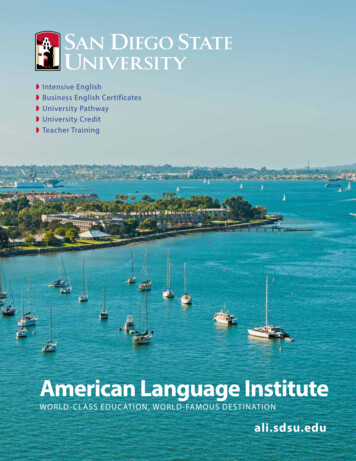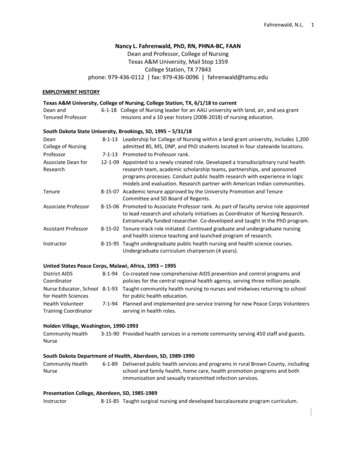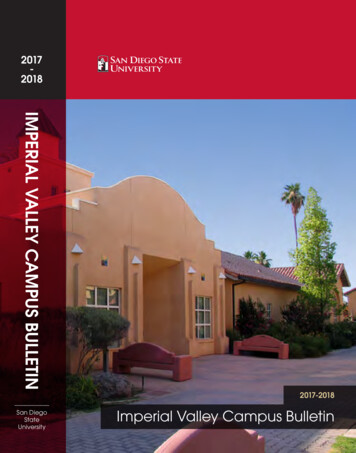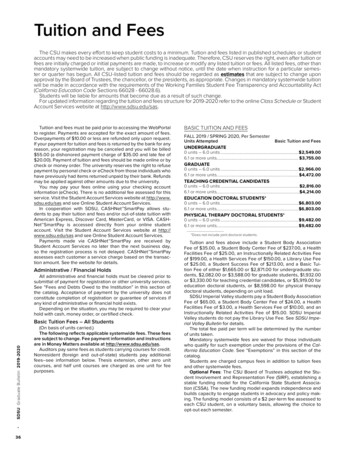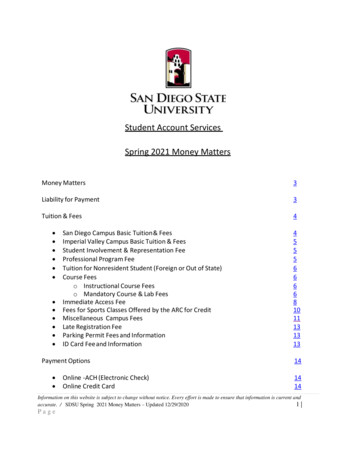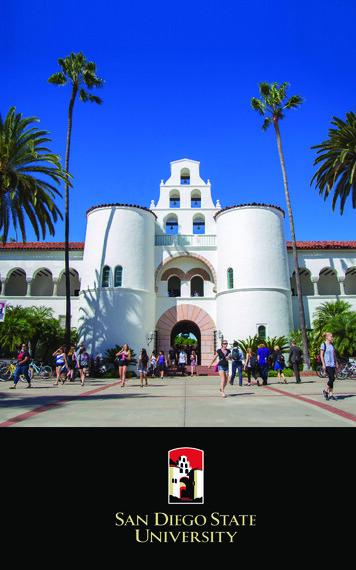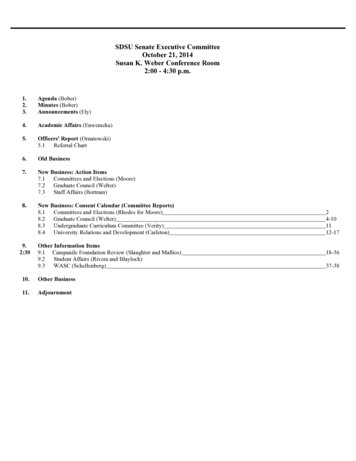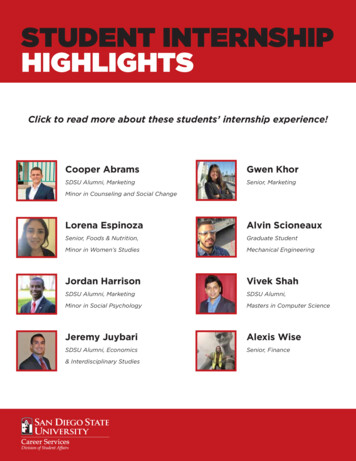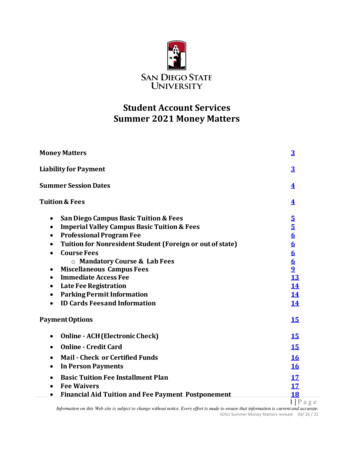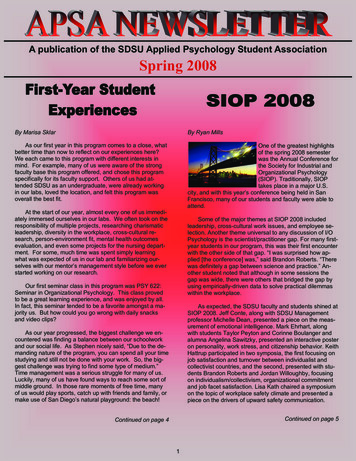
Transcription
A publication of the SDSU Applied Psychology Student AssociationSpring 2008By Marisa SklarBy Ryan MillsAs our first year in this program comes to a close, whatbetter time than now to reflect on our experiences here?We each came to this program with different interests inmind. For example, many of us were aware of the strongfaculty base this program offered, and chose this programspecifically for its faculty support. Others of us had attended SDSU as an undergraduate, were already workingin our labs, loved the location, and felt this program wasoverall the best fit.One of the greatest highlightsof the spring 2008 semesterwas the Annual Conference forthe Society for Industrial andOrganizational Psychology(SIOP). Traditionally, SIOPtakes place in a major U.S.city, and with this year’s conference being held in SanFrancisco, many of our students and faculty were able toattend.At the start of our year, almost every one of us immediately immersed ourselves in our labs. We often took on theresponsibility of multiple projects, researching charismaticleadership, diversity in the workplace, cross-cultural research, person-environment fit, mental health outcomesevaluation, and even some projects for the nursing department. For some, much time was spent simply learningwhat was expected of us in our lab and familiarizing ourselves with our mentor’s management style before we everstarted working on our research.Some of the major themes at SIOP 2008 includedleadership, cross-cultural work issues, and employee selection. Another theme universal to any discussion of I/OPsychology is the scientist/practitioner gap. For many firstyear students in our program, this was their first encounterwith the other side of that gap. “I was surprised how applied [the conference] was,” said Brandon Roberts. “Therewas definitely a gap between science and practice.” Another student noted that although in some sessions thegap was wide, there were others that bridged the gap byusing empirically-driven data to solve practical dilemmaswithin the workplace.Our first seminar class in this program was PSY 622:Seminar in Organizational Psychology. This class provedto be a great learning experience, and was enjoyed by all.In fact, this seminar tended to be a favorite amongst a majority us. But how could you go wrong with daily snacksand video clips?As our year progressed, the biggest challenge we encountered was finding a balance between our schoolworkand our social life. As Stephen nicely said, “Due to the demanding nature of the program, you can spend all your timestudying and still not be done with your work. So, the biggest challenge was trying to find some type of medium.”Time management was a serious struggle for many of us.Luckily, many of us have found ways to reach some sort ofmiddle ground. In those rare moments of free time, manyof us would play sports, catch up with friends and family, ormake use of San Diego’s natural playground: the beach!As expected, the SDSU faculty and students shined atSIOP 2008. Jeff Conte, along with SDSU Managementprofessor Michelle Dean, presented a piece on the measurement of emotional intelligence. Mark Ehrhart, alongwith students Taylor Peyton and Corinne Boulanger andalumna Angelina Sawitzky, presented an interactive posteron personality, work stress, and citizenship behavior. KeithHattrup participated in two symposia, the first focusing onjob satisfaction and turnover between individualist andcollectivist countries, and the second, presented with students Brandon Roberts and Jordan Willoughby, focusingon individualism/collectivism, organizational commitmentand job facet satisfaction. Lisa Kath chaired a symposiumon the topic of workplace safety climate and presented apiece on the drivers of upward safety communication.Continued on page 4Continued on page 51
Kevin SearsSenior ManagerAmgenKevin Sears, Senior Manager of Operations Trainingand Development at Amgen and SDSU graduate, recentlyshared his experiences about the field of training and development with current SDSU students. Kevin’s vast arrayof experience includes a variety of organizations such asBolt Consulting, Navy Personnel Research DevelopmentCenter, and Center for Creative Leadership. These experiences and his work at General Dynamics as a SeniorTraining Specialist led him to his current position at Amgenwhere he has been for over four years. Mr. Sears sharedgreat advice with the first and second year M.S. students.He suggested that the need for quality of life is essentialwhen choosing an organization to work for. While opportunities in I/O Psychology may be ample throughout thecountry, it is important to consider other factors such asfamily or geographic location. He also stated the need forlearning as much as possible through any job you take andunderstanding the company you work for. While I/O Psychology is an applied field, Kevin mentioned the need forstudents to speak the business language and be able totranslate what we understand in I/O through a businessvernacular. Ayala, R., Wilson, L., Yamashita, H., & Kath, L.M.(2008, February). The perception of risk in the workplace. Poster presented at the 1st annual San DiegoState University Student Research Symposium, SanDiego, CA. Conte, J. M., & Dean, M. A. (2008, April). An overviewof and update on the measurement of emotional intelligence In D. L. Rhodes & D. A. Newman (Chairs),Measuring emotional intelligence: How and why?Symposium presented at the 23rd Annual Conferenceof the Society for Industrial and Organizational Psychology, San Francisco, CA. Ehrhart, M.G., Peyton, T., Boulanger, C., &Sawitzky, A. (2008, April). More helping morestress? It depends on who you are. Interactive posterpresented at the 23rd annual meeting of the Society forIndustrial and Organizational Psychology, San Francisco, CA. Huynh, W., Czerwinski, M., & Kath, L.M. (2008, February). Exploring the influences of different levels ofsupport on safety training climate. Poster presented atthe 1st annual San Diego State University Student Research Symposium, San Diego, CA. Luu, L. D., & Hattrup, K. (2008, April). Country differences in the relationship between job satisfaction andturnover. Paper presented at the 23rd Annual Conference of the Society for Industrial and OrganizationalPsychology, San Francisco, CA. Makransky, G., & Glas, C.A.W. (2008, July). An automatic online calibration design in adaptive testing.Paper presented at 6th annual conference of the International Test Commission, Liverpool, England. Marks, K. & Kath, L.M. (2008, April) Drivers of upwardsafety communication. In L. M. Kath & A. K. McGonagle (Co-chairs), Relationships between supportive workenvironments and worker safety outcomes. Symposium conducted at the 23rd Annual Conference of theSociety for Industrial and Organizational Psychology,San Francisco, CA. Mills, R., Hitchcock, E., & Kath, L.M. (2008, February). The influence of environmental factors on individual safety motivation. Poster presented at the 1st annual San Diego State University Student ResearchSymposium, San Diego, CA.Tanya Goodwin-MaslachLearning Development ManagerQualcommTanya Goodwin-Maslach, Learning Development Manager at Qualcomm, recently came to speak to the SDSUApplied Psychology students about her extensive consulting experience and her career path. Tanya initially was adirector at TalentSmart, focusing on consulting and productdevelopment, before moving on to her current position atQualcomm. In addition, Tanya also worked as a consultantfor numerous years. Through her experience, she stressedtwo important points to all students interested in pursuing acareer in I/O Psychology: to develop strong and genuinerelationships and understand the business vernacular.Specifically, she stated that networking with colleagues,classmates, and so forth is invaluable in the businessworld. Furthermore, understanding the business languagewill help students better express what they know in I/OPsychology in business terms. Lastly, she discussed that agood work-life balance is a necessity and how well thesetwo balance truly depends on the individual.Continued on page 3Continued on page 4Note: Names in bold indicate faculty, students, or alumniaffiliated with the Applied Psychology program.2
Buelna, C., Ulloa, E.C., & Ulibarrri, M. D. (in press).Power as a mediator of the relationship between dating violence and sexually transmitted infections. Journal of Interpersonal Violence. Devos, T., Blanco, K., Muñoz, C., Dunn, R., & UlloaE. C. (in press). Implicit orientation toward family andschool among bilingual Latina/o college students.Journal of Social Psychology. Ehrhart, K. H., Roesch, S., Ehrhart, M. G., & Kilian,B. (in press). A test of the factor structure equivalenceof the 50-item IPIP five-factor model measure acrossgender and ethnic groups. Journal of Personality Assessment. Congratulations to Dr. Jörg Matt!As of Fall 2008, Jörg will beChair of the PsychologyDepartment at SDSU.Presentations continued Hattrup, K., & Roberts, B. G. (in press). What are thecriteria for adverse impact? In J. L. Outtz (Ed.), Adverse impact: Implications for organizational staffingand high stakes selection. San Francisco: JosseyBass.Kath, L.M., Swody, C.A., Magley, V.J., Bunk, J.A., &Gallus, J.A. (in press). Cross-level, three-way interactions among workgroup climate, gender, and frequency of harassment on job-related outcomes of sexual harassment. Journal of Occupational and Organizational Psychology. Ulloa, E.C., Jaycox, L., Skinner, S., & Orsburn, M. (inpress). Attitudes about violence and dating amongLatino/a boys and girls. Journal of Ethnic & CulturalDiversity in Social Work. Yabko, B., Hokoda, A., & Ulloa, E. C. (in press). Depression as a mediator between family factors andpeer bullying victimization in Latino adolescents. Violence and Victims.Note: Names in bold indicate faculty, students, oralumni affiliated with the Applied Psychology program.Don’t forget to join theAPSA LinkedIn Group!For more information,contact Dr. Lisa Kath atlkath@sciences.sdsu.edu.3 McGonagle, A.K., Mathieu, J.E., & Kath, L.M. (2008,April) A multi-level look at upward safety communication. In L. M. Kath & A. K. McGonagle (Cochairs), Relationships between supportive work environments and worker safety outcomes. Symposiumconducted at the 23rd Annual Conference of the Society for Industrial and Organizational Psychology, SanFrancisco, CA. Peyton, T., & Ehrhart, M.G. (2008, February). Emotional deviance in customer service employees: Individual factors and perceived job stress. Oral presentationat the 1st annual San Diego State University StudentResearch Symposium, San Diego, CA. Peyton, T., & Ehrhart, M.G. (2008, March). Theoretically examining emotional deviance: Predicting antecedents of an overlooked construct. Paper presented atthe 29th Annual Meeting of the Industrial/Organizational and Organizational Behavior GraduateStudent Conference, Denver, CO. Roberts, B. G., Willoughby, J., Hattrup, K., & Müller,K. (2008, April). Individualism/collectivism and the relationship between facet satisfaction and commitment. Paper presented at the 23rd Annual Conferenceof the Society for Industrial and Organizational Psychology, San Francisco, CA. Robinson, R., & Kath, L.M. (2008, February). The mediating role of job satisfaction in the job stress-intent toquit relationship: A study of grocery store employees. Poster presented at the 1st annual San DiegoState University Student Research Symposium, SanDiego, CA. Robinson, R., & Kath, L.M. (2008, April). The mediating role of job satisfaction in the job stress-intent to quitrelationship: A study of grocery store employees.Poster presented at the Western Psychological Association Conference, Irvine, CA.
First Year Student Experiences continued Speakers Corner continued So now our year’s coming to a close, which means“Party Time!!!” What are we going to do with such luxurious amounts of time? A very select, lucky, few will be traveling to Peru this summer, while the majority of us will beworking our internships and hopefully making significantheadway on our theses.Andrea JacksonSenior Employee Relations SpecialistQualcommAndrea Jackson, a Senior Employee Relations Specialist at Qualcomm and Applied Program graduate, recently spoke with current SDSU students on a variety oftopics. Andrea has spent the last three years at Qualcomm focusing on facets of employee relations such asaffirmative action and ethics. In talking with the students,she discussed the flexibility of the Industrial/Organizationaldegree in organizations. However, Andrea also suggestedthat students first focus on getting into an organizationwhich will eventually allow for movement around the company itself. She also mentioned that students should startthinking about where they want to work, such as big companies versus small, external consulting versus an internalposition, and so forth. Overall, she stated that some of themost valuable tools she has gained from the program atSDSU have been her presentation skills, teamwork, coordination within group projects, and networking.Looking back at all of our first year experiences, wehave all enjoyed everything this program has to offer.From attending classes, SIOP, and APSA BBQs, to gettingthe opportunity to apply our experience through class projects, we have all learned so much over the year and havegrown close with one another. Although the program isdemanding, it is a wonderful program that is worth all of thework.Over the course of this year, we have all gained pearlsof wisdom we would like to share with the Fall 2008 incoming first year students. We hope you will take these wordsof advice to heart, and enjoy your first year in this program! Be prepared to work hard.Don’t be afraid to ask questions.Work with your classmates to get assignments done.Don’t just learn how to manage your time—startmanaging it now.You spend a lot of time reading about your thesis topic.So, seriously think about what you are interested in,and base your thesis on that.Dr. Karsten MüllerProfessorUniversity of MannheimDr. Müller, Professor at the University of Mannheim,came to SDSU recently to give a presentation on crosscultural research and collaboration as well as studyingabroad in Mannheim. He specializes in employee surveysand cross-cultural organizational change. In terms of collaboration, Dr. Müller frequently partners with Dr. KeithHattrup, a resident professor here at SDSU. In addition toproviding a wealth of information on the effectiveness ofemployee surveys in managing a diverse internationalwork force in multi-national organizations, Dr. Müller alsotalked to students about coming to University of Mannheimfor a semester of study. The cross-cultural exchange between University of Mannheim and San Diego State University was founded originally by Dr. Jörg Matt and Dr.Werner Wittmann. Dr. Müller discussed the benefits ofspending a semester abroad, both in terms of personaland career growth, and suggested that it is an experienceall Applied Psychology students should consider.It’s never too early to start making plansto attend SIOP 2009!When: April 2 - 4, 2009Where: New Orleans, LAFor more information:http://www.siop.org/conferences4
SIOP 2008 continued A unique aspect of SIOP is the Job Placement Service, which assists students in their final year of coursework to network and interview with potential post-graduateemployers. Although the service was generally seen ashelpful, a couple of students pointed out ways to get moreout of it. Taylor Peyton remarked, “I think the job placement service would be most useful if you begin your jobhunt about two months in advance of the conference. Thiswould enable you to have plenty of time to set up interviews with the companies that interest you most.” In addition, Alice Wastag noted that preference of location playsa role: “The placement center only had one job posted forthe area I was looking for It might be more useful if youare very flexible and willing to move anywhere.”Other advice for students planning on attending nextyear included, “Figure out what your main goal for the tripis and focus on that I knew that networking for a job wasa top priority and I focused on that.” Other students recommended utilizing the index of the official program to searchfor the names of people whose symposia you’d like to attend most. In addition, finding the right balance betweenapplied and academic symposia is critical.Above: First-year students BrandonRoberts and Ryan Mills look at theSIOP schedule.SIOP 2008 was a huge success. Our entire I/O facultyparticipated in presentations, and many of our students didas well. In speaking with many students and faculty, people’s greatest highlight of SIOP 2008 was far and awaythat so many of us were able to attend and enjoy the conference together!Above: Keith Hattrup,Karsten Müller, andstudents present aposter at SIOP 2008.Right: Group pictureafter a SIOP interactiveposter session.5
Above (left to right):Back Row: Ryan Mills, Brandon Roberts, Jordan Willoughby, William Huynh, Taylor Peyton, Mark Ehrhart,and Stephen Vong.Front Row: Corinne Boulanger, Linsey Dirkes, Lisa Kath,Nora Grace Awkerman, Alice Wastag, and Keith Hattrup.Above: Mark Ehrhart’s lab presents at a SIOP interactive poster session.Right: Jeff Conte’s lab smiles for a group picture atSIOP.6
Tiffany Adams took a job with Qualcomm as an HRRepresentative in January of 2008. Addie Brewer recently became engaged. She will begetting married next summer in San Diego. In addition, she will be joining the SDSU/UCSD clinical psychology joint doctoral program this fall. Amelia Burns. Exploring Predictors and Outcomes ofBurnout in Young Adults within a College Setting. April2008. Chair: J. Conte. Marissa Crane. Eating Disorders at San Diego StateUniversity: Needs Assessment for Eating DisorderScreening and Referral on a College Campus. April2008. Chair: J. Matt.Amelia Burns is in the process of starting her ownbusiness called A Better Choice Nanny and Babysitting Agency and is projected to be up and running inthe summer of 2008. Bri Hays (Allgire). The Impact of Emotional Regulation and Resilience Curriculum on the Retention of AtRisk Students: An Evaluation of the Bounce Back Retention Program. April 2008. Chair: S. Roesch.Dr. Ulloa and his wife, Dr. Monica Ulibarri, are expecting a baby in December. Alice Wastag. Validity Evidence Linking Polychronicityto Time Urgent Behaviors. May 2008 Chair: J. Conte.7
Left: First-year students (left toright): Jessika Reliford, TressaSchultze, Brandon Roberts,Stephen Vong, Linsey Dirkes andRyan Mills.Right: Second-year students (leftto right): Jordan Willoughby, Taylor Peyton, Addie Brewer, CorinneBoulanger, Alice Wastag, andWilliam Huynh.Left: Faculty (left to right): JeffConte, Jörg Matt, MelodySadler, Mark Ehrhart and LisaKath (with Emi).The student editors of this issue were Alice Wastagand Stephen Vong.If you would like additional information on theApplied Psychology Student Association (APSA) oranything discussed in this newsletter, please e-mailDr. Mark Ehrhart at mehrhart@sunstroke.sdsu.edu.8
using empirically-driven data to solve practical dilemmas within the workplace. As expected, the SDSU faculty and students shined at SIOP 2008. Jeff Conte, along with SDSU Management professor Michelle Dean, presented a piece on the meas-with students Taylor Peyton and Corinne Boulanger and alumna Angelina Sawitzky, presented an interactive poster


